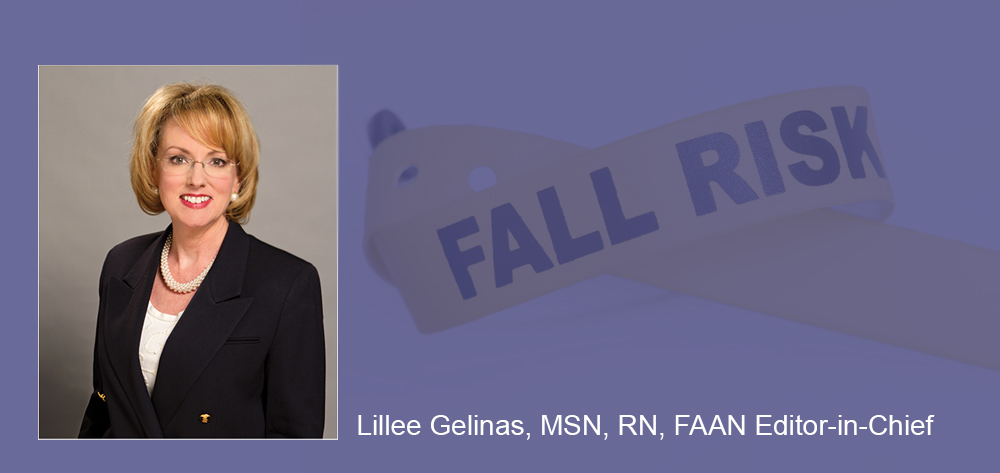Yes, I’m talking about falls here! Why is it so hard to take what we KNOW, and make it what we DO? We know best practices, we know frequent causes, so given the enormous human and financial consequences (2020, the annual direct and indirect cost of fall injuries is expected to reach $54.9 billion) of falls, especially falls with injury and immobility, what’s stopping us from solving this problem? What’s stopping us is that it’s hard, really hard.
Milestones
Although it’s hard, that hasn’t stopped individuals and organizations from trying. Here are a few milestones marking those efforts.
- Declaring it important. The 2005 Hospital National Patient Safety Goals from The Joint Commission included, for the first time, the goal to reduce the risk of patient harm resulting from falls by requiring hospitals to implement a falls-reduction program. In 2010, this requirement was upgraded to a standard.
- Measuring accurately. In existence for years, the National Database of Nursing Quality Indicators® (NDNQI®) gives us data to compare injury fall rates based on severity of injury, and other nurse sensitive indicators, in reports comparing like-units in like-facilities based on criteria such as bed size, teaching status, and Magnet recognition status.
- Endorsing the measures. In 2013, the National Quality Forum endorsed two NDNQI measures: patient fall rate and patient falls with injury.
It’s hard to argue with hard data
Despite these efforts, patient falls are the most frequently reported adverse event in the adult inpatient setting, and the results are costly to hospitals and patients. Annual fall related acute-care costs are estimated at $1.08 billion; for long-term care the estimate is $4.9 billion. And remember, falls and injuries from falls can exact a toll on caregivers as well.
About 30% to 51% of falls in hospitals result in some injury. When CMS released nine leading hospital adverse conditions targeted for reduction, fall injury and associated immobility were the primary targets. Falls without injury were not targeted.
Most of us can relate in some way to this reality; for me it’s personal, too. When my mother fell and broke her hip, her life changed, as did my life and my family’s.
Fear of falling
Falls also cause psychological problems for both fallers and non-fallers, including fear, self-doubt, activity avoidance, and loss of confidence, which may lower the quality of life. Among older adults who have fallen, 29% to 92% fear they’ll suffer another fall.
Among those who haven’t fallen, 12% to 65% fear they will so fear of falling or of a fall-related injury may be as disabling as a fall itself.
What works
Why is solving the problem of falls so hard? Because anticipating and coordinating care while engaging patients and families in the dialog is mission critical, but the interventions known to work are not universally used, regularly highlighted, and consistently documented. These interventions include:
- data, data, data — at the unit level
- nursing unit dashboards
- bedside shift report
- individualized goal setting
- whiteboard communication
- hourly rounds
- safety huddles.
Knowledge is power
Ongoing education can help make the hard work to address falls a bit easier, and American Nurse Today is committed to providing some of that education. In 2011, we published a special supplement titled: “Best Practices for Falls Reduction: A Practical Guide,” which you can access at https://myamericannurse.com/special-supplement-to-american-nurse-today-best-practices-for-falls-reduction-a-practical-guide/. I still refer to this excellent reference today. In 2014, we published the supplement “Current Topics in Safe Patient Handling and Mobility,” available at https://myamericannurse.com/resources/current-topics-in-sphm/, and watch for a special section on falls prevention in our July issue.
It’s also important to know interventions to protect patients from injury are separate and distinct from fall prevention. I first understood this key distinction thanks to Pat Quigley, PhD, MPH, ARNP, FAAN, associate director, VISN 8 Patient Safety Center of Inquiry. A nationally known researcher in falls prevention, she is my “go-to” person for falls evidence such as the Falls Prevention Toolkit available at http://www.patientsafety.va.gov/professionals/onthejob/falls.asp.
“Falling” forward: Getting to a better future
It will take all of us to do the painstaking work to reduce falls, but most importantly, it’s the frontline staff who can identify and address specific problems—if they have reliable data, and the education, technology, and hardware needed to support them.
We need to remember quality indicators link nursing care to patient outcomes. We need good data to continue to form that link. Let’s fall forward to a better future, with nursing care at its best and support systems allowing it to reliably happen. That is NOT so hard!
Selected references
Oliver D, Healy F, Haines TP. Preventing falls and fall-related injuries in hospitals. Clin Geriatr Med. 2010;26(4):645-92.
Quigley P, White S. Hospital-Based Fall Program Measurement and Improvement in High Reliability Organizations. Online J Issues Nurs. 2013;18(2):5.
Lillee Gelinas, MSN, RN, FAAN
Editor-in-Chief


















